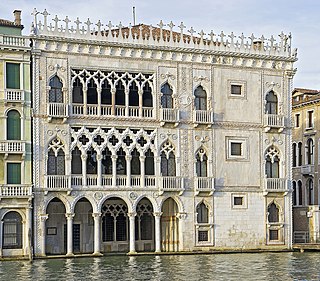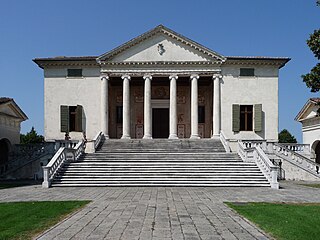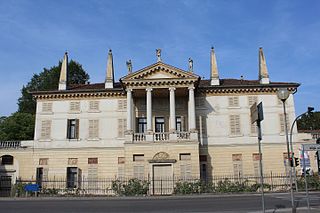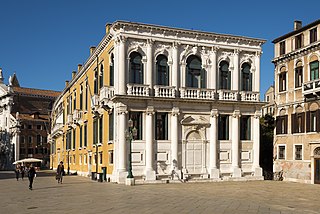
The Doge's Palace is a palace built in Venetian Gothic style, and one of the main landmarks of the city of Venice in northern Italy. The palace was the residence of the Doge of Venice, the supreme authority of the former Republic of Venice. It was built in 1340 and extended and modified in the following centuries. It became a museum in 1923 and is one of the 11 museums run by the Fondazione Musei Civici di Venezia.

The Grand Canal is a channel in Venice, Italy. It forms one of the major water-traffic corridors in the city.

The Brenta is an Italian river that runs from Trentino to the Adriatic Sea just south of the Venetian Lagoon in the Veneto region, in the north-east of Italy.

Bassano del Grappa is a city and comune, in the Vicenza province, in the region of Veneto, in northern Italy. It bounds the communes of Cassola, Marostica, Solagna, Pove del Grappa, Romano d'Ezzelino, Campolongo sul Brenta, Conco, Rosà, Cartigliano and Nove. Some neighbourhoods of these communes have become in practice a part of the urban area of Bassano, so that the population of the whole conurbation totals around 70,000 people.

The Ca' d'Oro or Palazzo Santa Sofia is a palace on the Grand Canal in Venice, northern Italy. One of the older palaces in the city, its name means "golden house" due to the gilt and polychrome external decorations which once adorned its walls. Since 1927, it has been used as a museum, as the Galleria Giorgio Franchetti.

Villa Badoer is a villa in Fratta Polesine in the Veneto region of northern Italy. It was designed in 1556 by Italian Renaissance architect Andrea Palladio for the Venetian noble Francesco Badoer, and built between 1557 and 1563 on the site of a medieval castle, which guarded a bridge across a navigable canal. This was the first time Palladio used his fully developed temple pediment in the façade of a villa.

The Riviera del Brenta is an area of the Metropolitan City of Venice of particular tourist-cultural interest due to the great architectural heritage of the Venetian villas built between the 15th and 18th centuries by the nobles of the Venetian Republic along the river Brenta.

Villa Pisani at Stra refers to the monumental, late-Baroque rural palace located along the Brenta Canal at Via Doge Pisani 7 near the town of Stra, on the mainland of the Veneto, northern Italy. This villa is one of the largest examples of Villa Veneta located in the Riviera del Brenta, the canal linking Venice to Padua. The patrician Pisani family of Venice commissioned a number of villas, also known as Villa Pisani across the Venetian mainland. The villa and gardens now operate as a national museum, and the site sponsors art exhibitions.

Fiesso d'Artico is a town in the Metropolitan City of Venice, Veneto, Italy. The town is connected by the SR11, and is part of the Riviera del Brenta.

The House of Loredan is a Venetian noble family of supposed ancient Roman origin, which has played a significant role in shaping the history of the entire Mediterranean. A political dynasty, the family has throughout the centuries produced a number of famous personalities: doges, statesmen, magnates, financiers, diplomats, procurators, military commanders, naval captains, church dignitaries, writers, and lawyers.

Ca' Loredan Vendramin Calergi is a 15th-century palace on the Grand Canal in the sestiere (quarter) of Cannaregio in Venice, northern Italy. It was commissioned by the patrician Loredan dynasty, namely Andrea Loredan, and paid for by Doge Leonardo Loredan, with construction starting in 1481. The architecturally distinguished building was the home of many prominent people through history and was the place where composer Richard Wagner died.

Francesco Loredan was a Venetian statesman and magnate who served as the 116th Doge of Venice from 18 March 1752 until his death in 1762. He was a member of the noble House of Loredan, head of its Santo Stefano branch, and the only Doge, as well as the last male, to be awarded the Golden Rose by the Papacy.

Ca' Loredan is a 13th-century Romanesque-style former palace of the Loredan family located on the Grand Canal in Venice, northern Italy. It is located in the sestiere (district) of San Marco and faces the Grand Canal, not far from the Rialto Bridge. Together with the annexed Ca' Farsetti, it is currently home to the city's municipal council.

The Museo Rossimoda della calzaturatrans. Rossimoda Museum of the Shoe is located in Villa Foscarini Rossi at Stra, which lies along the Riviera del Brenta in the mainland portion of the province of Venice, Italy.

Villa Foscarini Rossi is a Baroque-style aristocratic rural palace located at Via Doge Pisani 1/2, along the Riviera del Brenta, at Stra on the mainland of the Veneto, northern Italy. The Villa now houses a museum of shoes.
Loredan is a Venetian surname. The House of Loredan is an aristocratic Venetian family that included various doges of the Republic of Venice, and the surname is almost exclusively associated with the family. The surname most likely originated from the toponym Loreo, which itself originated from its Latin name Lauretum, meaning laurel. Another theory of the origin of the surname, though most likely legendary, is that it comes from the Latin epithet Laureati, given to ancestors of the Loredan family due to their historical glory in ancient Rome and the many victories they achieved in battles. The surname is spelled Loredano or Loredan in Italian, Lauredano or Lauredanus in Latin, and Lorentano (Λορεντάνο) in Greek, though it is also historically found as Lordas (Λορδᾶς) and Lordano (Λορδάνο). The feminine name Loredana, common in Italy and Romania, was likely inspired by the surname.

The Palazzo Loredan at Campo Santo Stefano is a palace in the San Marco district of Venice, overlooking Campo Santo Stefano. Before the acquisition by the Loredan family in 1536 and the restoration by the architect Antonio Abbondi, it was a group of adjacent buildings, in the Gothic style, belonging to the Mocenigo family. The purchased buildings were substantially restored and made into a single building for the residence of the wealthy noble family of Loredan. The palace has throughout history been home to at least seven Doges of Venice.

Villa Spineda Gasparini Loredan is an 18th-century Palladian style villa of the noble Loredan family located in the town of Volpago del Montello in the Veneto region of northeast Italy. It is regarded as one of the most beautiful villas of the Veneto.

Villa Razzolini Loredan is a 17th-century villa located in Asolo in the Veneto region of northeast Italy, historically owned by the noble Razzolini and Loredan families.

The Venetian patriciate was one of the three social bodies into which the society of the Republic of Venice was divided, together with citizens and foreigners. Patrizio was the noble title of the members of the aristocracy ruling the city of Venice and the Republic. The title was abbreviated, in front of the name, by the initials N.H., together with the feminine variant N.D.. Holding the title of a Venetian patrician was a great honour and many European kings and princes, as well as foreign noble families, are known to have asked for and obtained the prestigious title.




















